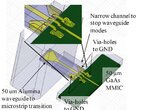WimRFP
Advanced Member level 5

- Joined
- Apr 16, 2010
- Messages
- 1,589
- Helped
- 594
- Reputation
- 1,176
- Reaction score
- 538
- Trophy points
- 1,393
- Location
- Netherlands
- Activity points
- 15,026
Something simulator related. When simulating patches very close to another meshed layer (for example small local ground), things can go wrong.
When you simulate a small horizontal rectangle above a non-meshed (infinite) ground plane layer, results are mostly good, even if the distance to ground < mesh size of rectangle. However when the ground is just another metallic layer that needs to meshed, thing can go complety wrong. From my experience with old versions of IE3D, results are fine if the mesh size << distance between structures, or the mesh of the rectangle should be aligned with the mesh in the meshed ground layer. I suppose it will be the same in HFSS and other MoM based simulators.
If came across this when simulating some planar resonating structures that had small local (floating) ground layers that needed to be meshed also.
Wire diameter: Is your wire diameter in the image properly scaled, or is it much smaller in reality or in your simulation? Diameter affects characteristic impedance of your CPW bond wire structure.
When you simulate a small horizontal rectangle above a non-meshed (infinite) ground plane layer, results are mostly good, even if the distance to ground < mesh size of rectangle. However when the ground is just another metallic layer that needs to meshed, thing can go complety wrong. From my experience with old versions of IE3D, results are fine if the mesh size << distance between structures, or the mesh of the rectangle should be aligned with the mesh in the meshed ground layer. I suppose it will be the same in HFSS and other MoM based simulators.
If came across this when simulating some planar resonating structures that had small local (floating) ground layers that needed to be meshed also.
Wire diameter: Is your wire diameter in the image properly scaled, or is it much smaller in reality or in your simulation? Diameter affects characteristic impedance of your CPW bond wire structure.





